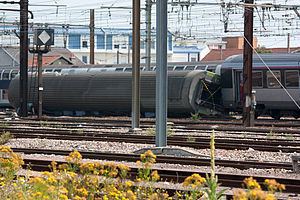Time 17:11 CEST (UTC+02:00) Cause Track defect Passengers 385 Number of deaths 7 Passenger count 385 | Trains 1 Date 12 July 2013 Country France Injuries 192 | |
 | ||
Similar Gare de Lyon rail accident, Granges‑près‑Marnand train crash, Eckwersheim derailment, Lac‑Mégantic rail disaster, December 2013 Spuyten | ||
Faulty points system blamed for br tigny sur orge train crash in france
On 12 July 2013, a train crash occurred in the commune of Brétigny-sur-Orge in the southern suburbs of Paris, France, when a passenger train carrying 385 people derailed and hit the station platform. Seven people were killed and nearly 200 were injured.
Contents
- Faulty points system blamed for br tigny sur orge train crash in france
- Accident
- Response
- Investigation
- Causes
- References
The accident was cited as the most serious rail crash in France since the 1988 Gare de Lyon accident in which 56 people were killed.
Accident
At 17:11 CEST (15:11 UTC) on 12 July 2013, SNCF Corail Intercités train 3657 from Paris Gare d'Austerlitz to Limoges derailed and crashed at Brétigny station, resulting in the deaths of seven people (three passengers on the train and four on the platform) and injuries to "dozens" more. 385 passengers were on board, which occurred a few minutes after the train departed Austerlitz at 16:53. It was scheduled to arrive at Limoges-Bénédictins at 20:05. The trains and platforms at Brétigny were particularly busy as it was the Friday before the Bastille Day holiday weekend.
Reports indicate the train, which was not scheduled to stop, crashed at 137 km/h (85 mph) (below the speed limit of 150 km/h) and split in two between the fourth and fifth carriages after they derailed on a double slip. The rear of the train deviated to the left from Track 1 to Track 3 at the following railroad switch. The sixth carriage moved laterally between the two tracks and swept the intermediate platform, being pierced by a roof beam. The fifth carriage first hit the platform on its left and came to rest along the opposite platform.
Response
Railway workers immediately took action, preventing, by a few seconds, a collision between the derailed carriages and another approaching from the opposite direction.
According to a police report, some thefts from passengers and throwing of projectiles at rescue workers occurred shortly after the accident. The Minister of Transport Frédéric Cuvillier and Interior Minister Manuel Valls described the incidents as "isolated acts" and said the throwing of missiles ceased when the police arrived.
Investigation
The SNCF, French Land Transport Accident Investigation Bureau (BEA-TT), and judicial authorities started three separate investigations into the accident.
The SNCF released its initial findings on 13 July 2013, reporting that the derailment appeared to have been caused by a track failure. A steel fishplate connecting two rails came loose 200 metres (660 ft) from the station at a set of switches, and became stuck in them. The last axle of the third carriage is thought to be the first to have hit the fishplate.
Causes
Three investigations were initiated, by the Évry public prosecutor, the Land Transport Accident Investigation Bureau (BEA-TT) of the Ministry of Transport, and the SNCF. The train is believed to have derailed on the approach to Brétigny when passing over a switch 200 metres (660 ft) before the station. The French transport minister Frédéric Cuvillier stated that the accident was not due to human error and ruled out any responsibility on the part of the driver.
At a press conference the day after the accident, an SNCF director stated that the failure of a fishplate (rail joint) was the cause of the accident, confirmed in the third SNCF press conference by supporting photographs. According to Guillaume Pepy, the SNCF president, the fishplate broke away from the rails and became lodged in the middle of the switch, causing the derailment.
Pepy said the SNCF considered itself responsible for the lives of its passengers and announced a campaign to check all similar equipment, nearly 5,000 units throughout the network, whose maintenance is within the SNCF's remit.
